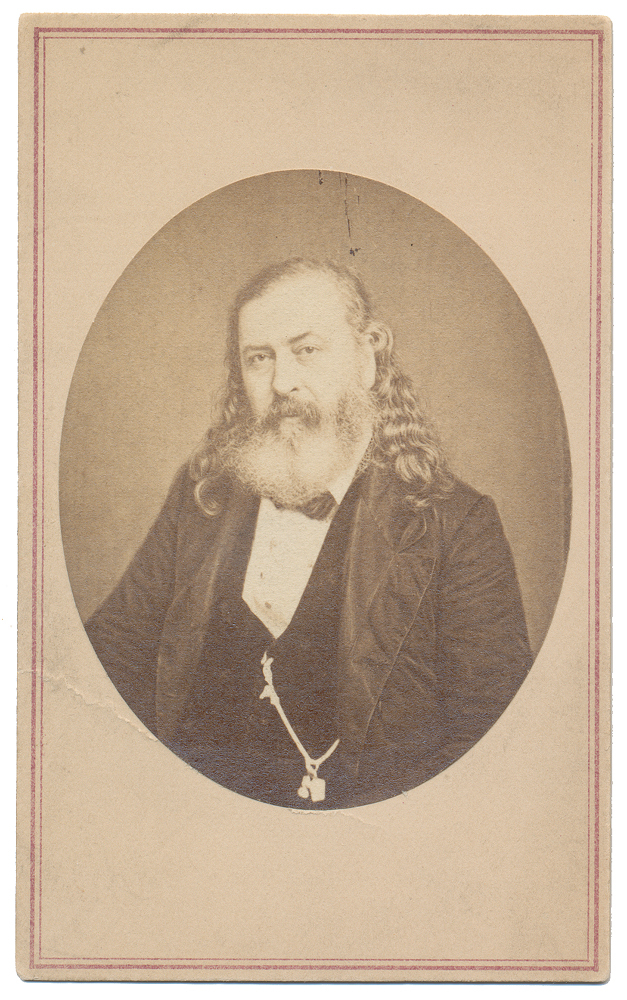site search
online catalog
POST-WAR VIEW OF GENERAL ALBERT PIKE

Hover to zoom


$350.00
Quantity Available: 1
Item Code: 1138-442
Shipping: Determined by Method & Location of buyer
To Order:
Call 717-334-0347,
Fax 717-334-5016, or E-mail
Image shows Pike in a dark civilian suit sporting his usual long locks of hair.
Clarity and contrast are excellent and the paper and mount are the same.
Reverse has a photographer’s imprint of R. A. LEWIS…NEW YORK. Nice period ink ID at top reads “ALBERT PIKE JR. (OF ARKANSAS.) Collector information in pencil at bottom.
From the collection of the late William A. Turner.
Albert Pike was born in Boston, Massachusetts on December 29, 1809. He received his early education at Newburyport and Framingham, and in 1825 entered Harvard College, supporting himself at the same time by teaching. He only went as far as the junior class in college, when his finances compelled him to continue his education alone, teaching, meanwhile, at Fairhaven and Newburyport, where he was principal of the grammar school, and afterward had a private school of his own.
In later years he had attained such distinction in literature that the degree of Master of Arts was bestowed upon him by the Harvard faculty. In 1831 he went west with a trading party to Santa Fe. The next year, with a trapping party, he went down the Pecos River and into the Staked Plains, whence with four others he traveled mostly on foot until he reached Fort Smith, Ark.
His adventures and exploits are related in a volume of prose and verse, published in 1834. While teaching in 1833 below Van Buren and on Little Piney River, he contributed articles to the Little Rock Advocate, and attracted the attention of Robert Crittenden, through whom he was made assistant editor of that paper, of which he was afterward for two years the proprietor.
He was admitted to the bar in 1835 and studied and practiced law until the Mexican War, when he recruited a company of cavalry and was present at the battle of Buena Vista under the command of the famous Col. Charles May. In 1848 he fought a duel with Gen. John S. Roane on account of something said by him in his story of that battle, which the governor considered as reflecting unjustly on the Arkansas regiment.
In 1849 he was admitted to the bar of the Supreme Court of the United States at the same time with Abraham Lincoln and Hannibal Hamlin. In 1853 he moved to New Orleans, having prepared himself for practice in the courts of Louisiana by reading the "Pandects," of which he translated the first volume into English. He also made translations of many French authorities.
He wrote, besides, an unpublished work of three volumes upon "The Maxims of the Roman and French Law." In 1857 he resumed practice in Arkansas. He acted for many years as attorney for the Choctaw Indians, and in 1859, assisted by three others; he secured for them an award by the United States Senate of $2,981,247. He was the first proposer of a Pacific railroad convention, and at one time obtained from the legislature of Louisiana a charter for a road with termini at San Francisco and Guazemas.
When the war of secession began he cast his fortunes with the South, and was Confederate commissioner to the tribes of Indian Territory. As such he brought the Creeks, Seminoles, Choctaws, Chickasaws and part of the Cherokees into alliance with the Confederate States. On August 15, 1861, he was commissioned brigadier-general in the army of the Confederate States, and at the battle of Pea Ridge he commanded a brigade of Indians.
On November 11, 1862, he resigned his commission, on account of some unpleasant relations with General Hindman, and appealed to the authorities at Richmond, when the dispute was settled and the matter dropped. From this time he disappears from Confederate military history, but he remained true to the Confederacy to the last.
After the war he resided in Memphis, Tenn., and edited the Appeal in 1867. The next year he moved to Washington, D. C., and practiced in the courts until 1880. From that time until his death, which occurred at Washington, April 2, 1891, he devoted himself to literature and to freemasonry. He was the highest masonic dignitary in the United States, and was author of several valuable masonic works. He is buried in Oak Hill Cemetery, Washington, D.C. [ad] [ph:L]
~~~~~~~~~~~~~~~~~~~~~~~~~~~~~~~~~~~
THIS ITEM, AS WITH ALL OTHER ITEMS AVAILABLE ON OUR WEB SITE,
MAY BE PURCHASED THROUGH OUR LAYAWAY PROGRAM.
CLICK HERE FOR OUR POLICIES AND TERMS.
THANK YOU!
Inquire About POST-WAR VIEW OF GENERAL ALBERT PIKE
Most Popular
Historical Firearms Stolen From The National Civil War Museum In Harrisburg, Pa »
Theft From Gravesite Of Gen. John Reynolds »
Selection Of Unframed Prints By Don Troiani »
Fine Condition Brass Infantry Bugle Insignia »
Large English Bowie Knife With Sheath 1870’S – 1880’S »
Imported (Clauberg) Us Model 1860 Light Cavalry Officer's Saber »
featured item
CIVIL WAR MUSICIAN’S GROUPING INCLUDING WARTIME IDENTIFICATION DISK, IDENTIFICATION SHIELD, AND FREEMANTLE ROTARY VALVE CORNET/VALVED BUGLE: JOHN J. WEAVER- 10th and 56th PA- AND CUTLER’S BRIGADE BAND 1861-1865
This wonderful grouping includes two wartime identification badges, a rotary valve cornet dating about 1864, along with his GAR membership badge and veteran’s id badge. To top it off, in addition to prior service in the 10th PA from April 26 to… (1179-420). Learn More »


